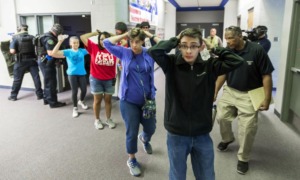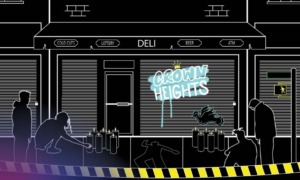Many whiskeys into another night of binge-drinking and recovering from a neck injury that had numbed his left side, Jamie Scott King pushed an FNX-40 pistol into his temple. He fingered the trigger, a copper-coated bullet waiting in the chamber, with 14 more behind it.
King’s own frustration stopped him: he’d so forcefully pressed the gun against his head that his hair got tangled in the barrel, the sensation jolting him. Still, just months into life after a more than three-year stint in the Army, the 33-year-old was unnerved.
“The guilt and shame kept growing,” King said, of why he wanted to kill himself inside his Oxford, Miss. home. “It kept getting bigger and it felt like it wasn’t going to change.”
Daily, an average of 17 U.S. veterans has resorted to suicide, taking their lives at a 52.3% greater rate than other Americans did in 2019, when 6,261 veterans died by suicide. Firearms were involved in 69.2% of those deaths, according to a U.S. Department of Veterans Affairs report released last September, based on the federal agency’s most recent data. Veterans aged 34 and younger died at a higher rate than any other former service members. And while suicide rates declined overall for non-veterans between 2001 and 2019, according to the V.A.’s report, they rose for veterans.
“Some veterans come back broken and we expect them to apologize for their problems, but we won’t apologize for making them this way,” said Marine Corps veteran Andrew Newby, assistant director of veterans and military services at the University of Mississippi, where King is Student Veterans Association president.
Often, veterans carry with them the ghosts of lives lost — and the ghosts of their former selves. No longer feeling fully military nor fully civilian, many confront a crisis of identity and purpose that frequently leads to isolation, depression and alcohol and drug addictions. Some 37,000 veterans were homeless on the solitary night in 2020, when the U.S. Department of Housing and Urban Development collected data for a report released in 2021.
For those leaving military service, the federal Transition Assistance Program provides about a week’s worth of classes about finances, job-hunting, transferring military skills to a civilian workforce and so on. Yet, some experts argue, that isn’t always enough.
What’s also needed, among other things, experts say, are exit camps, if you will, offering transition-driven orientations akin to what new enlistees get during boot camp; encouraging physicians outside the V.A. to routinely ask patients whether they are veterans and, based on their need, direct them to mental health and other resources; investing in adaptive sports such as wheelchair basketball to improve physical and mental health; easing access to disability compensation; and expanding the G.I. Bill to include funding for business start-ups for entrepreneurial veterans. Those kinds of efforts could improve the quality of life for veterans before any among them contemplates dying by suicide.
Years later, vet “dreams that I’m still there”
When Jobie Charlie was 11, he watched from his Tucker, Miss., school playground as the Army National Guard 367th maintenance company rolled past during Operation Desert Storm. Seeing them, a teacher forewarned that the next war would be the “end of days,” a Biblical promise of the world’s end. Young Charlie cried, vowing to himself he would never join the military.
Nine years later — months before the 9/11 attacks — high school dropout Charlie, 19, joined that very unit. At the time, he’d earned the general educational development certificate that stood in for his 12th-grade diploma. He was tired of working electronic factory jobs that didn’t pay enough to support him and his toddler son. He was hoping the Army would bring him the male role models missing from his own life.
With the rank of specialist, he deployed to Iraq in 2003.
Sitting on a couch in the Dancing Rabbit Golf Club on his ancestral Choctaw reservation in Philadelphia, Miss., Charlie, now 41, reflected on his time in the Middle East. A tattoo etched across his upper right arm in Arabic reads: “I was in pain. So I learned, so I changed.”
“It’s not bad,” he said, pausing. “Mmmmmm….”
His fiancé, sitting nearby, interjected. “You can’t minimize it,” Kat Strangeman said.
“There were times we were shot at,” Charlie continued. “There are times it felt like I didn’t breathe until it was all over.
“Every now and then, I feel … ” He paused again. “I’ll have dreams that I’m still there or I’m going there.”
Sometimes, in his nightmares, Charlie is on a convoy, bullets firing in his direction. Sometimes, he is lost and surrounded by a mob, uncertain who among that crowd wants to kill him. Always, mortar hurtles toward him. He sees it coming before it explodes.
And, then, sometimes, Lt. Matt Stovall comes into view as Charlie last saw him: running toward his convoy. Moments later, a homemade bomb blew him up.
“I can see him now, running slowly, waving,” Charlie said. “When I re-see it, I see him slowly fading away.”
Around the time of the first COVID-19 shutdown, Charlie fell into a deep depression. He’d just turned 40, graduated from the University of Mississippi with a finance degree and, after two decades of military service, retired as a sergeant from the Army National Guard.
The suicidal ideation that was part of the fallout from being on the battlefield returned during the pandemic. Heavy drinking numbed him to recurring nightmares: “It’s easy to get drunk and have a deep sleep where you don’t have to wake up with terrors and think about what happened in Iraq.”
Then, in November 2020, a childhood friend who’d deployed with him died in a drunk driving accident. Social worker Strangeman, a therapist for the Mississippi V.A. who wasn’t speaking as a clinician, called their friend’s death deliberate self-destruction. “Chronic alcohol use is suicide,” she said, tears in her eyes. “It’s a slow death, it’s a slow heartbreak.”
Charlie cut down on his alcohol consumption after that fatal car wreck, which came two months after he’d undergone a psychological evaluation at the V.A. After clinicians there handed him an official diagnosis of post-traumatic stress disorder in December 2020, he started seeing a mental health professional and taking antidepressant and anti-anxiety medications.
He credits his love for his three children for pulling him away from the bottle. “I didn’t have a dad,” he said, “so I don’t want them to go through that.”
Injury may worsen mental traumas of military
By the time Jamie Scott King, a 2005 college dropout, re-enrolled at the University of Mississippi in 2017, he had never felt more alone. His marriage was unraveling. His relatives wondered why he’d left the military. Months out of a complicated neck surgery, he still lacked sensation on his left side, though doctors had said it would return.
Wary of their prescribed pain pills, he instead downed a 25-ounce bottle of Monkey Shoulder whisky a day.
As a 30-something on a campus composed mainly of younger students, he struggled to connect with classmates. He overheard a professor say that King should have gotten college right the first time.
King had returned to campus an injured man. Two weeks before his slated January 2015 deployment to Iraq, his parachute had malfunctioned during a routine jump out of an aircraft. He’d hurtled to the ground, crashing headfirst in an open, North Carolina airfield on that training day. Afraid he wouldn’t be allowed to deploy, he didn’t complain about his throbbing neck. He wound up leaving for Iraq as scheduled.
He returned to the Army base in Fort Bragg, N.C. almost a year later, the numbness worsening. For a while, he kept quiet. He didn’t want his new commanders and platoon leaders to see him as he saw himself, broken and needing to be fixed.
Instead, he worked his way up to a section leader, directing fire teams and armored vehicles. A sergeant once remarked, “If King comes up and tells you he’s hurt, believe him. Because King never comes up hurt.”
Then, during another routine exercise in 2017, he watched his fellow soldiers, one after another, as their bodies were sucked out of a paratroop door, one of their arms clutching a yellow static line strung from the aircraft’s ceiling that automatically opened their parachutes.
Back on base since his injury, King had once jumped from the aircraft’s right door. But this time he’d been positioned on the left side, with no room to move over. If he jumped, he couldn’t securely hold the line. And if he lost control, it could wrap around his throat — or the throat of the person behind him.
After refusing to take that plunge, King spiraled through several months of shame and seclusion. He was placed on grueling 24-hour security shifts. Prove you’re in pain, his superiors insisted.
According to medical records from early 2017, that neck injury was “consistent with radiculopathy,” a pinched spinal nerve from an earlier bad jump.
In May 2017, shortly after King’s neck surgery, the Army released him from active duty. He drove off base with 180 pain pills and no health insurance.
Many veterans forego V.A. health care
It took more than a decade for Atlanta veteran Andrew Davenport, 37, to receive full military benefits. He’d spent eight years in the National Guard, deploying to Iraq in 2005. He was diagnosed with PTSD around 2016.
As with many among the roughly 200,000 service members who leave the military each year, Davenport’s problems, he said, started as soon as he left. Experts acknowledge a “reverse culture shock” of reintegrating into civilian life. Often, relocating, returning to school, searching for employment and other changes exacerbate the transition.
While week-long transition classes must be offered to veterans, a loophole in the law lets the Department of Defense wave through those who choose to bypass the courses.
And some do skip the classes. Such transition programs may “not be viable due to the unpredictable nature of military activities at the end of service,” the not-for-profit MITRE Corp. noted in a 2019 report.
Last year, the U.S. Government Accountability Office reviewed nine military installations, including one in Meridian, Miss. and three elsewhere in the South, providing those mandated transition services to military members. The GAO’s 23-page letter to Congress reported that, at most of those installations, at least 85% of newly deactivated service members took the required job-related and other courses. However, officials at most of the locations said that employment opportunities for veterans were limited.
A New Veteran, which Davenport is launching, aims to serve veterans like him — he also pondered suicide — so others do not wait years to understand and tell their stories or get the financial support to which they are entitled.
“We want veterans to define themselves,” Davenport said. “We want to take the stigma out of ‘This is the homeless vet,’ ‘This is the crazy vet.’ We want you to define what you, as a veteran, look like.”
So far, Davenport has probed the military experiences of about 60 veterans: How did that make you feel? Do you think a person of the opposite sex, different color, similar rank would have been treated that way?
Davenport’s project is one bid to help patch what some say are vast holes in the safety net. Last year, the V.A. funneled an unprecedented $297 million into suicide prevention initiatives. V.A. data suggests that veterans making use of their mental health services are less likely to die by suicide than those who don’t.
But fewer than half of all veterans are enrolled in V.A. health care. About 60% of those who killed themselves in 2019 had not stepped inside a Veterans Health Administration clinic for mental or other health care in the years leading to their deaths, noted Dr. Umar Latif, a psychiatrist and medical director of Help for Heroes.
“Was it an access to care issue or were these veterans not ‘identifying’ as veterans and seeking care elsewhere?” asked Latif, whose nationwide organization treats mental health and substance use disorders. He urged those who work with former service members to “look for barriers to access so that more veterans don’t fall through the gaps.”
[Related article: As suicide rates for women veterans rise, more of them are by firearms.]
Requiring primary physicians to ask about and record their patients’ military status would more readily enable veterans to tap into available services, said Dr. Harold S. Kudler, a Duke University School of Medicine psychiatrist and former director of the V.A.’s Mid-Atlantic Mental Illness Research, Education, and Clinical Center.
“The problem is that most clinicians outside the Department of Defense and V.A. don’t routinely ask the question,” said Kudler, a researcher for, among other studies, a 2017 analysis of the post-deployment mental health of Iraq and Afghanistan war veterans. “This national blind spot can only be corrected through a sustained community effort.”
Self-denial delays diagnosis, treatment
Dr. Ken Lee returned from Iraq in 2005 with a Purple Heart in 2005 — and a desire to take his own life.
A suicide bomb had left him with a traumatic brain injury, multiple shrapnel wounds and musculoskeletal and nerve damage, among other ailments, while the medical battalion commander and his soldiers were delivering supplies to Baghdad’s heavily fortified Green Zone. Flown back stateside to recover, he felt worthless.
Also, he was in denial that he had symptoms typical of PTSD.
“A lot of vets are in that situation,” recalled Lee, now 57, a retired Army colonel and chief of spinal cord injury at the Milwaukee V.A. Medical Center.
“As a physician who had treated others with PTSD,” he added, reflecting, “it seemed kind of unreal to me that I had it, too.”
His accumulated troubles during the two years after that bombing — “probably the darkest moments of my family’s life” — sent him into his basement with a pistol, in April 2007. But his wife’s screams over their 7-year-old son hurting himself while jumping on the bed disrupted the suicidal ideation.
“I dropped everything and ran upstairs,” Lee said. “That was the big change.”
He got an official diagnosis of PTSD. He began competing in wheelchair lacrosse, one of the adaptive sports that has heightened his and many of his patients’ wellness and sense of belonging to a community. “Loneliness is real and that is your biggest culprit,” he said. “Go out and be with somebody, so there’s someone you can lean on if things go the wrong way.”
In Cleveland, Miss., the Rev. Seth Still is encouraged that, during COVID-19, more veterans and active-duty military personnel seem to be reaching out for help with depression and other drivers of suicide.
The pandemic’s stressors “probably allowed folks to share some things they might not have otherwise shared,” said Still, chaplain for the 172nd Airlift Wing of the Mississippi Air National Guard. “When everybody is down and confused and afraid, then it’s, like, ‘Yeah, me too.’”
Still, 41, also a church pastor, counts himself among veterans who’ve suffered deeply from their experiences in the military. His job had him recovering dead bodies from crash sites of a failed Kyrgyzstan-to-Afghanistan mission in 2013 and a fatal training exercise in Mississippi in 2017.
In the first few months after returning from Afghanistan, Still was fixated on the Glock he kept in a bedroom drawer. “Whenever I’d open that drawer and see that pistol it would cross my mind: ‘You could get rid of all this pain and sadness.’”
Confessing those temptations to his wife made the urges subside. He removed the gun from their house: “That’s a huge part of it, just telling someone what’s going on and getting it out of your head.”
For some, masking pain is part of the process
When he was inside the University of Mississippi Student Veterans Association’s offices, Jamie Scott King tended to give the impression that he was doing just fine. He was, veteran Jobie Charlie said, always “laughing and sharing stories. He made anyone that walked into the building feel like they were his long lost brother.”
His public joviality aside, King still was drinking himself to sleep.
That fall night in 2018, sitting in a brown recliner where he’d spent months recuperating from that Army injury, the force of his own hand made the pistol’s slide — the part that recoils after pumping out a bullet — catch in his curls.
Alone in his office, he couldn’t help laughing at himself, at his absurd preoccupation with a few stray strands of hair.
“I put the pistol down and made myself another drink,” King said.
The next morning, in the university’s counseling center, he “just started unloading.”
“I still feel a little bit embarrassed about it, the fact I let it get that dark,” King recalled, sitting in the student veterans association campus house.
He curbed his drinking and, in 2019, started helming that association, moving it from what fellow vet Charlie described as a “basement dungeon” to its current home. Its food pantry is open to all students, in part, to help veterans better integrate into the wider college community.
King got divorced last year and is slated to graduate this spring with a degree in geology. That brown recliner still takes up space in his home. “But I don’t sit in it much anymore,” King said. “I’ve sat in it a lot less since that day.”
The Veterans Crisis Line can be reached by dialing 1 (800) 273-8255 pressing 1; texting 838255; or chatting online at http://veteranscrisisline.net/Chat.














































